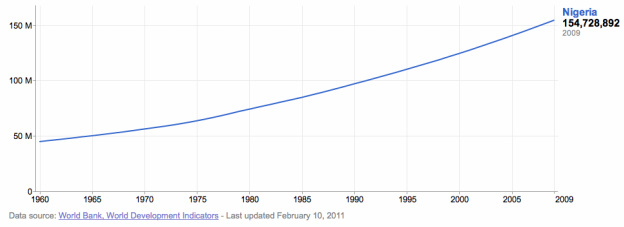Demographics
The most populous country in Africa, Nigeria accounts for approximately one-sixth of Africa's people. (CIA World Factbook, 2011)
Professor JG Ottong, a social scientist at the University of Calabar, explained that population has been a sensitive and controversial issue "because of its implications for shaping regional, state and ethnic relations and balance of power". In the past, census figures were believed to have been manipulated for political advantage. (BBC News, 2006)
Professor JG Ottong, a social scientist at the University of Calabar, explained that population has been a sensitive and controversial issue "because of its implications for shaping regional, state and ethnic relations and balance of power". In the past, census figures were believed to have been manipulated for political advantage. (BBC News, 2006)
Some Figures

Population pyramid of Nigeria (2010).
note: all figures appear from the CIA World Factbook unless otherwise specified.
Birth Rate: 36.07 births/1,000 population (29th in world)
Death Rate: 16.31 deaths/1,000 population (5th in world)
Total Fertility Rate: 4.82 children born/woman (29th in world)
Infant Mortality Rate: 92.99 deaths/1,000 live births (10th in world)
Life Expectancy at Birth: 47.24 years (221st in world)
Stage of Demographic Transition Model: Stage 2
The population pyramid of Nigeria shows a very young population, indicative of high birth rate. However, it also shows a slimming aged population, indicative of an increasing death rate or a low life expectancy. However, the wide base of the pyramid shows that population growth will most likely occur in the future, due to the number of potential parents found in the number of youth.
Birth Rate: 36.07 births/1,000 population (29th in world)
Death Rate: 16.31 deaths/1,000 population (5th in world)
Total Fertility Rate: 4.82 children born/woman (29th in world)
Infant Mortality Rate: 92.99 deaths/1,000 live births (10th in world)
Life Expectancy at Birth: 47.24 years (221st in world)
Stage of Demographic Transition Model: Stage 2
The population pyramid of Nigeria shows a very young population, indicative of high birth rate. However, it also shows a slimming aged population, indicative of an increasing death rate or a low life expectancy. However, the wide base of the pyramid shows that population growth will most likely occur in the future, due to the number of potential parents found in the number of youth.
Demographic Transition Model

BR, DR, and Pop. Growth in various stages of the DTM. (BFSG, 2011)
Nigeria is in stage 2 of the demographic transition model. Here are some characteristics of stage 2 countries that are visible in Nigeria's case.
Stage 2 - Early Expanding
Birth Rate remains high. Death Rate is falling. Population begins to rise steadily.
Reasons
Death Rate is falling as a result of:
However, although the death rate is falling in Nigeria, the birth rate remains high, and as you can see below, the population is rising steadily. In order for Nigeria to go into the 3rd stage, it needs to see:
Stage 2 - Early Expanding
Birth Rate remains high. Death Rate is falling. Population begins to rise steadily.
Reasons
Death Rate is falling as a result of:
- Improved health care (e.g. Smallpox Vaccine)
- Improved Hygiene (Water for drinking boiled)
- Improved sanitation
- Improved food production and storage
- Improved transport for food
- Decreased Infant Mortality Rates
However, although the death rate is falling in Nigeria, the birth rate remains high, and as you can see below, the population is rising steadily. In order for Nigeria to go into the 3rd stage, it needs to see:
- Family planning available
- Lower Infant Mortality Rate
- Increased standard of living
- Changing status of women
Population Trends

To view a Gapminder Simulation of Nigeria's population over time click here.
As shown in the graph to the right, Nigeria's population has been on a steady increase, and is expected to continue to increase dramatically.
